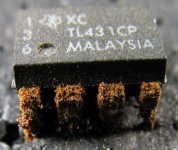Well, as a perspective, I like to fix old stuff, and have some of the things I coveted in the 70s and 80s because I came from a dirt-poor divorced family. I originally started teaching myself to fix electronics before I was 10, because most of my friends had TV sets and I did not. So while designing new computers was my love in the following decade, I began my learning experience by fixing things.
So now I buy old computers mostly to fix them.
I prefer to leave them as-is when I can, and absolutely hate this trend of replacing old electrolytics when they don't need to be replaced and weren't causing any fault, but if fixing means replacing stuff, then it gets replaced. Then I have a habit of hoarding the old faulty components as though they will be restored to the non-functional computer in the future.
Repair doesn't necessarily mean refurbishment, and I think there are three points to this discussion - Repair vs Refurbishment vs Preservation, forming a triangle ( or maybe even a two-axis alignment of Preservation/Repair and Original/Refurbished) and you can sit pretty much anywhere within it's scope. I do love repairing computers and was fortunate enough to work in a high workload repair center for two years, doing what I loved ( second only to making new computers, which is what I left there to do ) - and I sit close to repair and preservation, leaning towards repair.
However, I don't necessarily hate refurbishment either. There's something about an old computer that has been refurbished with new or replacement parts so that it looks new that has appeal. Also I see people who sit along the refurbishment/preservation line, who don't care anything about function as long as you don't see it -so they don't repair the PSU or other elements, or don't mind faulty PCBs remaining unrepaired.
I try to use original parts where I can for a repair, but will still use a modern replacement component if nothing else is available - especially where custom chips are concerned.
Also, if there's one thing that really annoys me about old plastic computers.... It's why do cables somehow melt their way into the casing??? I assume it's something to do with solvents breaking down, pressure between the parts, and gradual softening with continued force applied, usually by gravity, but is there really that much solvent in a cable or a case? Because they don't appear damaged much or melded together - they just seem to plastically deform together. Sometimes it's so bad I think that replacing the parts, even with modern reproductions, is the way to go.
But generally the yellowing of the plastic and the cable marks remain after the repair and tells more about what I feel is important with what I collect, that it does about my ideologies. More to say, the yellowing and even a bit of grime does not bother me nearly as much as seeing the device non-functional.
David


